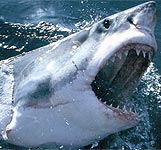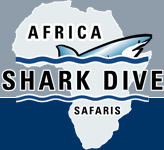|
|
BACK TO TOURS & PACKAGES: Great White shark cage diving
Cage Diving - General information
 Dyer Island is a small rocky island close to the fishing village of Gansbaai, on the Southern Cape coast of South Africa. The boat actually leaves from Kleinbaai; this is just outside the town of Gansbaai. Gansbaai is a two-hour drive away from Cape Town (180km).
How the day starts
The day at sea The rest of the day is spent watching, cage diving and enjoying the day. The trip out at sea between 4/5 hours.
The Cage Dive  For most of the year operators cannot make use of air or snorkel for some reason the sharks seem nervous of the bubbles coming out from the regulator. The dive master standing above you on the boat, will let you know when the shark is within your viewing range to hold your breath and go down, your head is just below the surface of the water.
Video
Seasons
Water and weather conditions
Items you will need on the boat
Boats ALL MARINE TRIPS ARE WEATHER DEPENDENT
GREAT WHITE SHARK - general information Carcharodon Carcharias Great White Sharks are a protected species along the coasts of California, USA, and Australia and have been a protected species in South Africa since April 1991. They average between 3.5 - 4.9 meters. Females are larger than males as with most sharks. Scientists believe that White Sharks give birth to 2-14 pups and are around 1, 5 meters long The eggs are fertilized and hatched within the female and are nourished by eating unfertilized eggs and smaller siblings in the womb. They have no placenta so the babies must fend for themselves, before birth. No maternal instincts are shown they swim away immediately after birth Great Whites use their powerful tails to propel themselves through the water. The fins are only used for balance. They need too stay moving as they will sink, they have no gas filled bladder to keep them afloat, they are heavier than water and their large oily liver provides some buoyancy. White Sharks cannot swim backwards. To do this they first need to stop swimming, fall backwards to propel themselves backwards. Great Whites swallow their food whole, their teeth ripping prey into mouth sized pieces. Sea lions and seals are part of their diet. The life span of the great white is not yet known.
Interesting Facts
|


FACTS ABOUT GREAT WHITE SHARKS AND SHARK CAGE DIVING ENCOUNTERS AT SHARK ALLEY AND DYER ISLAND IN GANSBAAI
copyright © Africa Shark Dive Safaris
solutions by MANTA SEO Solutions
